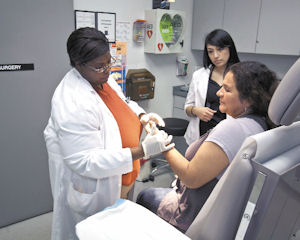A lower back injury costs the typical Southern California employer $58,560; a knee injury: $51,330; a sprain or tear: $47,570. Helping employers reduce those on-the-job injury costs — which according to the Workers Compensation Insurance Bureau totaled $8 billion in California last year — is the business of Valencia-based U.S. HealthWorks. The occupational health provider has been on a tear, acquiring 34 clinics in the last 18 months as part of an aggressive growth strategy to roll up the fragmented business of occupational health. It announced an 11-clinic acquisition in Tennessee Oct. 17, bringing total clinics to 167 in 15 states. The goal: to be “the leading outpatient occupational health provider in the U.S. with centers throughout the country,” vowed CEO Daniel D. Crowley. Revenues climbed past $250 million a few years ago, and the company is already the country’s number two operator, behind Addison, Texas-based Concentra. Now, with Concentra focused on building urgent care rather than occupational health centers under new owner, Humana Inc., Crowley believes he has a good shot at taking the top spot in occupational health. Helping him will be $205 million in fresh financing from GE Capital, raised in June. Crowley plans to use the money to continue to make acquisitions across the country while adding new services such as on-site orthopedics and acupuncture. With 80 percent of the occupational health business still controlled by single office and small group doctors, U.S. HealthWorks has plenty of room for growth. “It is a target-rich environment,” Crowley said. At the same time, the Valley company faces significant challenges. Workplace injuries have been declining since 2003, when the Bureau of Labor Statistics started to keep track. Private industry employers reported 3.3 million nonfatal occupational injuries in 2009, the latest figures available, down from 3.7 million cases in 2008. With nearly 90 percent of its business in occupational health, HealthWorks depends on a business in decline. It’s why Concentra has been expanding into urgent care. The recession has also hurt. “Local government agencies have traditionally been stable clients during economic downturns. This time they were hard hit, especially in California, which is our largest market,” Crowley said. And lately, complaints on various websites such as glassdoor.com and yelp.com have multiplied from both employees, who grumble that the company “sees each person who walks in the door as a dollar sign,” and patients sharing less than stellar experiences. It may all just be growing pains. Still, Crowley will have to address these issues if he wants to continue to make clients and investors happy. To grow the top line in an environment of declining workplace injuries, Crowley has focused not only on acquisitions, but taking market share from competitors and adding new services. To thrive in a recession, he has managed costs carefully, doubling margins to 30 percent at individual clinics, he said. “We are able to bring significant economies of scale and introduce new clients and services to centers we buy, so naturally, the margins increase,” Crowley said. If his past is any indication of the future, Crowley should do well — at least by investors. He joined the company in 2003 from Foundation Health Systems Inc., a failing leveraged buyout before he came on board. He built it into a Fortune 500 company that eventually became part of $10 billion, Woodland Hills-based Health Net Inc. “He is a driven and dynamic leader,” Senior Vice President Therese Hernandez said of Crowley. “He has infused the company with a sense of ownership and focus.” Added Mark Brooks, managing director of Scale Venture Partners, an initial investor that recruited Crowley in 2003: “he makes the trains run on time.” For employers facing rising workers compensation claims, that attitude can’t hurt. California’s worker compensation system was overhauled in 2003 to eliminate waste and abuse. Since 2006, however, costs have begun to creep up. Last year, losses per claim rose to $63,596 compared to $45,708 in 2005, according to the Worker’s Compensation Rating Bureau of California. Keeping a lid on medical expenses is critical if employees don’t want a return to the pre-reform days when workers comp insurance rates hit $6.29 per $100 of payroll. That’s where U.S.HealthWorks comes in. Rather than send an employee to his or her own physician, HealthWorks clients such as UPS, Frito Lay, Coca-Cola and Wal-Mart send them to U.S. HealthWorks centers. Physicians at these centers say they are focused not just on fixing the injury, but getting the worker quickly back to work. “It’s not just a benefit to the company, it helps the worker,” said Dr. Alesia Wagner, regional medical director for California. “Most studies show that workers who are not back on the job by six weeks tend not to return to the job at all. We focus on keeping the employees functioning after the first few days, (and) we encourage them to get up, keep joints moving and to stay on a schedule.” Such measures have helped HealthWorks get 80 percent of injured workers back to work within 30 days with no restrictions, she added. The industry average, she said, is closer to 70 percent. One way the company gets workers back earlier is by offering more on-site services, including podiatry, physical therapy, occupational therapy, chiropractic care, orthopedics, and even medically supervised psychotherapy and acupuncture. “That integrated approach benefits the worker and lowers the cost to the employer,” Dr. Wagner said. The company also offers a range of other services to clients, including drug testing and mandatory physical examinations. In recent years it has also ventured into safety training, with an eye on helping companies prevent injuries, said Hernandez. “We help America’s employers and workers be more productive and competitive,” added Crowley. “It’s a terrific calling.”
